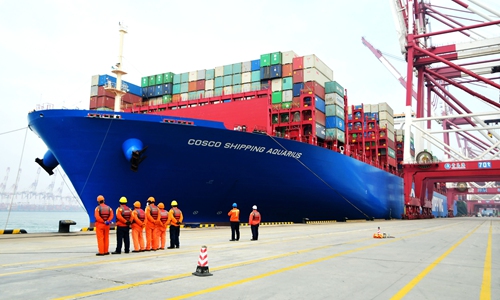HOME >> SOURCE
China to release more stimulus
By Shen Weiduo Source:Global Times Published: 2020/3/27 21:23:41
Nation to maintain prudent fiscal policy for world

A COSCO ship at Qingdao Port in East China's Shandong Province Photo: IC
China is set to roll out more stimulus to drive a slowing world economy after the G20 conference, where all countries vowed to coordinate in the face of the economic fallout from the COVID-19 pandemic, Chinese economists said.
China's upcoming efforts, which are expected to cover a wide range of measures, including cuts to reserve ratios and subsidy fee cuts for enterprises, will be more long-term oriented and moderate-paced instead of any "flood-irrigation" style the US has taken, which may have a certain effect on boosting market sentiment in the short term, but create bubble risks to the world economy, they noted.
The comments were made after the leaders of G20 members, following a "virtual summit" via video conferencing Thursday, vowed to inject more than $5 trillion into the global economy as part of a targeted fiscal policy, and to guarantee schemes to counteract the social, economic and financial impact of the pandemic.
"In the global battle against the economic fallout amid the virus, the $5 trillion is just the beginning, and the money will be used in areas such as tax cuts and subsidies to small and medium-sized firms that have been vulnerable in the epidemic," Cong Yi, a professor at the Tianjin University of Finance and Economics, told the Global Times on Friday.
The package is a summary of the measures that all G20 countries have taken or are about to take, China's foreign ministry spokesman Geng Shuang told a regular press conference on Friday, noting that China has released fiscal and monetary measures worth $344.1 billion to fight COVID-19 and stabilize the economy so far.
Geng said China has taken several measures, including more than 121 billion yuan ($17 billion) in epidemic prevention and control, as well as expected tax and fee reductions of more than 1 trillion yuan this year.
In the financial sector, China has already injected liquidity and targeted instruments such as reloans and rediscounts into the market amounting to $184.8 billion, Geng said.
More stimulus, such as more tax cuts, consumption boost, subsidies to firms and measures to stabilize employment are also on the way, experts said.
Cuts to reserve ratios will also be considered, but the central bank may not use the tool before the end of April, Wang Jun, Chief economic economist at Zhongyuan Bank Co, told the Global Times on Friday, predicting that the decision might be made cautiously based on China's first quarter economic performance.
"The central government may also issue more debt to local authorities to boost spending," Wang said.
In stark contrast to China's prudent policy, the US has unveiled unprecedented measures to shore up its economy amid the virus - the US Federal Reserve vowed to buy an unlimited amount of government debt, as well as corporate and municipal bonds, in the biggest expansion of its balance sheet in history, after surprisingly dropping its benchmark interest rate to zero a week before.
The US may not have many tools now, and the move could also pose potential risks to the global economy, Cong said.
"Unlike the US that has 'fired all its bullets,' China still has more monetary policy leeway as it is committed to a prudent fiscal policy, which will benefit the world economy in the long run," Cong said.
Analysts said the foremost thing to do is to spare no efforts to contain the virus.
As China's situation has improved, and is accelerating a full-scale work resumption and production, in a bid to ensure the stability of the domestic and global supply chain, it's possible that China could be one of very first major economies to recover and become a stabilizer to the global economy, Liu Jianying, an associate research fellow at the Chinese Academy of International Trade and Economic Cooperation of the Ministry of Commerce, told the Global Times on Friday.
Posted in: ECONOMY